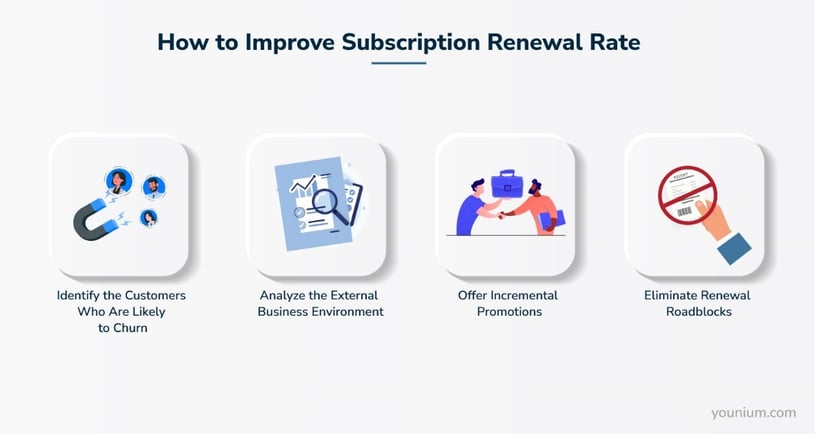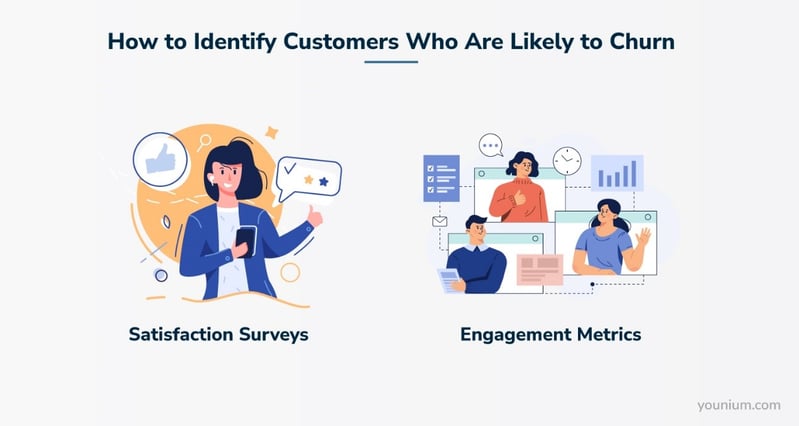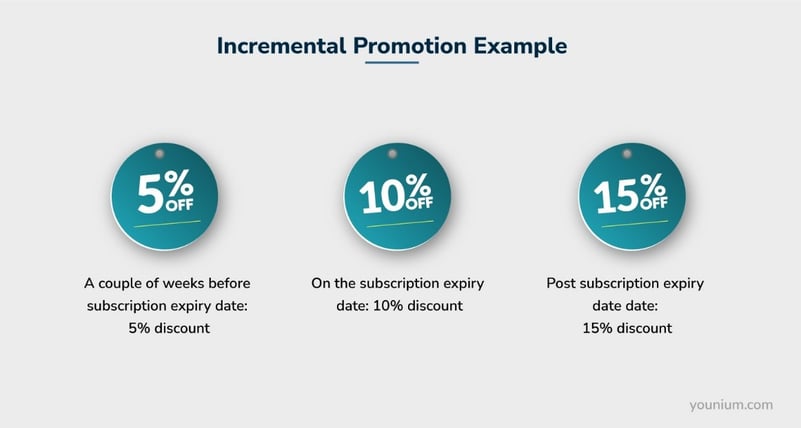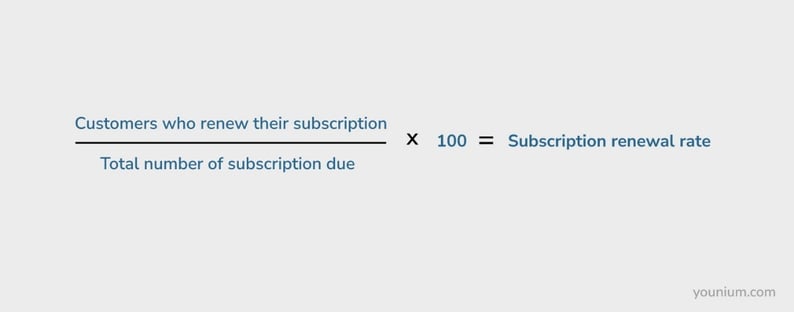How to Improve Subscription Renewal Rates - 4 Easy Steps
Learn how to improve subscription renewal rates in simple steps. Keep customers engaged and improve long-term customer loyalty with these actionable tips.
.png)
This post was last updated on October 28, 2024.
Jump to read
Key Metrics to Track Subscription Renewal Performance
How to Improve Subscription Renewal Rate
Best Practices to Improve Subscription Retention and Renewal Rates
Calculating Renewal Rates
FAQs
Wrapping up
How to improve subscription renewal rates — it’s a question that isn’t very new to subscription-based businesses.
Undoubtedly, these businesses have to focus on customer acquisition and retention to achieve long-term growth, consistent revenue, and success.
Although it does seem very straightforward in theory, improving the subscription renewal rate is quite tricky in the real business scenario.
Let’s take an example of your business.
You are dealing with a significantly lower subscription renewal rate for a particular product/service than your competition.
The reasons can be higher product/service prices, lack of features and utility, lower customer satisfaction, ineffective marketing communication, or maybe the issue is not from within your organization. Perhaps a new or better product/service is launched by a competitor.
Given that you run a business for revenue, your strategy cannot be based on trial and error. You need to put your brain into finding out the reason.
So, to answer the question of how to improve subscription renewal rates, here’s a detailed guide.
So, how can you improve your subscription renewal rates?
Here is how you can decrease churn without throwing a wrench on your revenue stream.
Key Metrics to Track Subscription Renewal Performance
Monitoring your subscription renewal performance can help you evaluate how well your retention strategy is working. By monitoring some key metrics, you can spot trends, predict renewal rates, and adjust your approach to keep customers. Below are the most important metrics to focus on:
- Churn Rate: This is an important metric that indicates the percentage of customers who cancel their subscriptions within a specific period. A high churn rate indicates a problem with customer satisfaction or retention.
- Customer Lifetime Value (CLV): CLV represents the total revenue generated by a customer over their entire relationship with your business. A high CLV suggests that customers are satisfied and likely to renew their subscriptions.
- Monthly Recurring Revenue (MRR): MRR is the total revenue recognized from recurring subscriptions each month. It's a crucial metric for understanding your business's financial stability.
How to Improve Subscription Renewal Rate
Following is a step-wise process of increasing the subscription renewal rate.

1. Identify the Customers Who Are Likely to Churn
It’s 2024, and most businesses (including yours) likely have a plethora of data about their customers, including their behavior, engagement rate, satisfaction level, etc.
The first step to improve your customer subscription renewal rate is to analyze current customer behavior to identify the ones who are most likely to churn.
Following are the metrics and techniques you can analyze for the same:

Satisfaction Surveys
There are various customer journeys where you can ask your customers about their experience with your products or services.
For example, you must have noticed an email or a mobile app pop up right after contacting the customer helpline of your service providers.
These satisfaction surveys can be held at multiple levels of a customer journey for gathering data. So, for your business case, think of a way you can ask your customers about their experience with your products/services.
The idea should be to reach out to this group of customers who are most likely to churn. By understanding their issues, you can find out where you need to improve and thus improve your subscription renewal rates.
Engagement Metrics
Unlike customer satisfaction information, you don’t need your customers’ input to obtain engagement metrics.
You might already be using a CSM (if you’re not, now is when you opt for one.), and it can provide you with critical information related to your customers’ engagement.
For example, your CSM tells you about the customers who haven’t used your product/service for the past few weeks. Consider them a part of the customers who might churn.
Do you see how easy things can be if you utilize data-powered business intelligence to improve subscription renewal rates?
Payment Behavior Analysis
Payment behavior is another critical factor often overlooked in churn analysis. If you're looking at how to improve subscription renewal rates, you need to pay attention to payment-related issues.
Examine customers' payment history to identify any trends or patterns that might indicate churn risk.
Issues like late payments, declined transactions, or frequently-paused subscriptions can signal potential churn. Also, monitor changes in subscription renewals, such as downgrades or upgrades.
Monitoring these patterns will allow you to identify customers who are more likely to cancel their subscriptions.
2. Analyze External Business Environment
When considering how to improve subscription renewal rates, you need to look beyond your business and analyze the broader market environment.
It's important to understand that your business does not exist in a silo. There are many factors outside of your control that can affect your subscription renewal rate. These factors include:
- Competitors: A new market entrant can disrupt the way a niche conducts business. Even if your customers are happy with your products/services, there are possibilities that some of your competitors might drop their prices to obtain a large chunk of market share.
- Economic Conditions: Recessions and other economic downturns can lead to customers canceling their subscriptions to save money.
- Technological Changes: New technologies can make your products or services obsolete.
- Regulatory Changes: New laws and regulations can make it more difficult or expensive to do business.
A thorough analysis of your external business environment can help you identify competitive threats and opportunities that can influence customer retention.
Here are two things you should do to incorporate external factors in your analysis.
Understand Your Competitors’ Strategies
Examine your competitors’ pricing models, marketing strategies, and value propositions.
Pay attention to new entrants who might be shaking up the market with innovative approaches or lower prices. Analyze your competitors’ pricing plans and offers and try to beat them by offering lower prices or a higher value proposition.
Also, if your competitors frequently update their products with new key features to attract new customers, keep a close eye on these updates. Compare your product's features with those of your competitors. Identify gaps where you can innovate or improve.
Highlight your unique selling points in your marketing to differentiate your brand and product. By doing so, you can convince your current customers to stay even if other options exist.
Understanding how your competitors are trying to attract new customers will help you adjust your retention strategies.
Identify Market Trends and Shifts
Understanding market trends is key to keeping your subscription model relevant and attractive. Trends in technology, consumer behavior, and economic factors can all impact how your customers perceive your value.
You can read industry reports, news articles, and market research regularly to stay informed about trends that might affect your business.
Resources like Statista, Gartner, and McKinsey offer insights into market shifts that could impact or improve your renewal rates.
Also, research new technologies and incorporate them into your processes. New technologies can alter consumer expectations.
For example, AI-powered services or advanced analytics tools might become standard offerings. By adopting new technologies early, you can set your brand apart and improve customer satisfaction.
3. Offer Incremental Promotions
It’s hard to resist offers. When you’ve identified the customers who are not likely to renew their subscriptions, you need to come up with a strategy to convince them to continue their subscriptions. This is the only way to improve your subscription renewal rates.
But how do you do that?
One great way is to offer discounts to entice them to renew their subscriptions.
It’s best to send the first renewal offer a couple of weeks before your customer’s subscription expiry date.
But here’s where you change things up.
You can start with a reasonable but low discount for the renewal.
If the customer doesn’t renew, send them another offer with an increased discount and post their subscription expiry date.

And how does this help?
If they’re sitting on the fence when it comes to the pricing, the higher discount rate might convince them to subscribe.
But here’s a word of caution.
No matter to what degree you believe your business exists to cater to your customers; there is a harsh reality that every discount you offer to your customers is a cut in your revenue.
When you aggressively offer discounts and price cuts to all of your current subscribers to complete their subscriptions, you head towards a rabbit hole where you, along with your competitors, participate in a race to the bottom.
So, make sure you use discounts wisely to improve revenue and subscription renewal rates.
4. Leverage a subscription management solution
Technology-powered subscription solutions like Younium lets you easily model and organize your B2B subscriptions. They eliminate your need to manage spreadsheets and custom databases manually.
Following are some of the advanced features subscription management solutions like Younium come along with:
- Automatic Booking with ACV, CMRR, and TCV measures
- Customer unique pricing
- Data capture and insights
- Full audit trail and versioning
- Multiple currencies and entities
Best Practices to Improve Subscription Retention and Renewal Rates
Subscription-based businesses thrive on customer loyalty and longevity. To ensure continued success, it's essential to implement strategies that can foster customer satisfaction and maintain high renewal rates.
Here are some best practices for how to improve subscription renewal rates.
1. Offer Consistently More Value Over Time
One of the key reasons customers cancel subscriptions is a lack of perceived value. To counter this, ensure that your product offers increasing value over time.
This could be in the form of new features, exclusive content, or premium customer service. By showing customers that staying with you gives them ongoing advantages, they will be more inclined to continue their subscription and even opt for longer contracts.
2. Personalize the Customer Experience
Personalization is a powerful way to connect with customers and build loyalty. When users feel like your service is tailored to their needs, they are more likely to stay.
When sending renewal reminders, for instance, use the customer’s name, refer to their subscription history, and highlight how they have benefited from your service.
Tailor your communication to reflect their usage patterns, preferences, and past interactions. For example, if a customer frequently uses a specific feature, mention it in your reminder, emphasizing its value.
3. Use Friendly and Timely Renewal Reminders
Don’t wait until the last minute to remind subscribers about an upcoming renewal. Gentle, well-timed reminders help users prepare for their subscription renewal without feeling pressured.
Consider sending a reminder at least a month before the renewal date, followed by another a week or two in advance.
These should include details on what’s included in the subscription and any improvements or added benefits since their last renewal.
To avoid sounding too transactional, keep the tone friendly and focus on the value they’ll continue to receive. Offering an incentive for early renewal can also help retain more subscribers.
Slack, for example, sends subscription renewal reminders that clearly mention the renewal date.

Image via Really Good Emails
4. Provide Excellent Customer Support
Outstanding customer support is a key differentiator for subscription businesses. Customers who feel supported are more likely to stay loyal.
Make sure your customer service team is accessible via multiple channels, knowledgeable, and ready to help with any issues.
Offer multiple ways and support channels, such as live chat, email, and phone support, so customers can reach out in their preferred way. This will help you resolve issues quickly and effectively, showing customers that they are your priority.
Also, consider investing in self-service options, such as detailed FAQs or how-to guides, to help subscribers resolve minor issues on their own. Proactive and responsive support can prevent cancellations, and increase the likelihood that customers will stick with your service.
5. Regularly Collect and Act on Feedback
Your subscribers are the best source of insights into what’s working and what’s not. Regularly collect feedback through surveys, in-app ratings, or post-purchase reviews.
But don’t just collect it—act on it. Address pain points, implement popular suggestions, and communicate any improvements or changes based on their feedback.
By making your subscribers feel heard, you strengthen your relationship with them and increase the likelihood of renewal.
6. Offer Flexible Subscription Plans
One-size-fits-all plans can alienate customers who don’t need all the features of your SaaS product. However, by offering multiple subscription plans with different pricing tiers, customers can choose what suits their budget and needs.
You can provide options like monthly, quarterly, and annual subscriptions, or usage-based pricing, so customers can switch plans if their circumstances change.
This flexibility can make them feel they have control over how much they’re paying and can sign up for a plan that best fits their current needs.
In addition, offer pause and resume options for subscriptions. If customers need a break for a certain time, allowing them to pause instead of canceling can help retain them in the long run.
This option can help reduce churn and keep such customers in your ecosystem, making renewal more likely when they’re ready to resume.
Companies like Mailchimp excel at offering multiple pricing tiers, allowing businesses to upgrade to higher-tier plans as their email marketing needs grow.

Image via Mailchimp
7. Reward Loyalty with Special Offers and Discounts
Everyone loves to feel appreciated, and incentives can be a strong motivator for subscription renewals. Offer discounts, bonus content, or exclusive perks for customers who renew their subscriptions early or commit to a long-term plan.
Consider introducing a loyalty program where long-term subscribers can unlock special perks over time.
With features like loyalty points, special badges, or access to VIP content, you can make customers feel like they are getting extra value by staying subscribed.
8. Engage with Customers Throughout the Subscription Period
Customer engagement shouldn’t start and end at the renewal point. Continuously engage with your subscribers by sharing valuable content, updates, and tips that keep them informed and excited about your SaaS product.
You can send newsletters, exclusive offers, and sneak peeks of new features to keep your brand top of mind. Engaged customers are more likely to see the value in your offering, making them more inclined to renew their subscriptions.
For instance, ZenDesk uses regular newsletters to highlight new product features, tips for using the platform, and customer success stories. This keeps users engaged and reassures them that the platform is worth the investment.

Image via Really Good Emails
9. Focus on Clear and Transparent Communication
Transparency is essential to keeping your customers' trust. Make sure all subscription terms are clear from the beginning, including renewal dates, pricing changes, and how to cancel if needed.
Hidden fees, surprise price hikes, or complicated cancellation processes can frustrate customers and drive them away.
Maintain regular communication about updates, promotions, and payments to ensure that customers don’t feel blindsided. If you’re raising prices or updating plans, explain the reasons clearly and highlight the added benefits customers will receive.
10. Provide Educational Resources and Great Onboarding
Many customers may need help understanding all the features and benefits of your product, which can lead to underutilization and a lack of perceived value.
As such, offering educational resources and comprehensive onboarding support can help customers get the most out of their subscriptions.
Create tutorials, webinars, or product walkthroughs that guide users through your platform. For new subscribers, provide step-by-step onboarding materials to help them get started smoothly.
By ensuring that customers know how to use your product effectively, you can increase satisfaction and the likelihood of them renewing their subscription.
Calculating Renewal Rates
Shouldn’t we have discussed this in the beginning? Well, many businesses use subscription management software like Younium, so they don’t have to calculate their customer renewal rate manually.
But, if you still want to learn how to calculate subscription renewal rates, here you go.
First, open your CRM and calculate the number of customers who renew their subscriptions at the end of their subscription period (CR).
Divide this sum by the total number of subscriptions due (RD). Lastly, multiply the outcome by 100 to convert the number into a percentage.
The mathematical formula will look like this - (CR/RD) x 100

FAQs
1. What is a good subscription renewal rate?In a general sense, a renewal rate of above 80% is considered favorable. It means that the business’s customer retention efforts are effective. Needless to say, every organization aims to bring its subscription/customer renewal rates closer to 100%.
2. What is the difference between subscription renewal rate and retention rate?These are different terminologies used for quite the same meaning but in different scenarios.
The subscription renewal rate is basically the retention rate in a subscription-based business model, whereas the retention rate is used in a general business environment.
The calculation method for both is the same.
3. What is the renewal rate?The renewal rate is the percentage of customers renewing their subscriptions with a SaaS company.
4. How to calculate subscription renewal rates?The formula to calculate subscription renewal rates over a specific subscription period is as follows:
(Number of customers who renewed their subscriptions ÷ Number of customers who should’ve renewed their subscription) x 100
5. How do I have better control over the renewal rates by leveraging the subscription dataFollow these simple steps to improve the subscription renewal rate for your SaaS business:
- Identify the subscribers who are more likely to churn out
- Look for competitors’ pricing and new offerings
- Offer incremental promotions to those subscribers who are not going to renew
- Leverage a subscription management solution to manage your entire customer lifecycle better
- Eliminate renewal roadblocks
Wrapping Up
In a competitive business environment where almost every business is using software solutions and tools to optimize their product strategy and customer life-cycle, it’s essential to invest in the right subscription management software that would allow your SaaS business to cope with the pace of the change.
Request a free demo of Younium here to learn how it can help you take control of your subscription management.